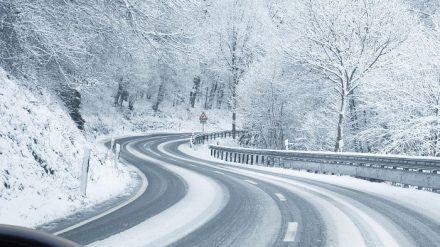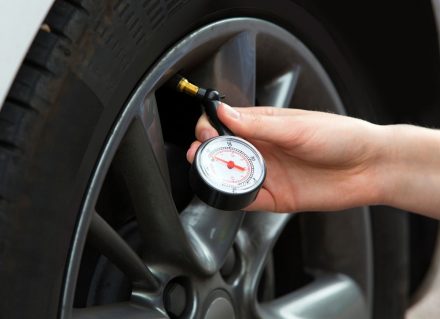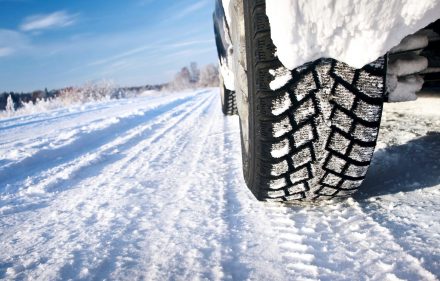
For those living in a temperate climate, chances are that at some point during the winter, roads will be covered with ice or snow. The reduced traction on the roads because of this make your vehicle harder to control and can challenge even the most experienced drivers. Almost 6,000 people are killed in weather-related traffic accidents annually, according to the U.S. Department of Transportation. The best way to deal with dangerous winter conditions is to not drive in them. However, if that is not an option, here are some helpful tips to help you get to your destination safely:
Be proactive:
Prepare.
It doesn’t hurt to have a supply kit with non-perishable food, water, blankets, gloves, reflective tape, and an extra cell phone charger. If you’re heading into more severe conditions, having a shovel is a good idea.
Avoid driving while tired.
Getting the correct amount of sleep before taking on winter weather tasks reduces driving risks such as falling asleep at the wheel. It is also common to have slower reaction time when you are tired.
Never warm up a vehicle in an enclosed area, like a garage.
Doing this leads to a serious risk of carbon monoxide poisoning. It takes less than two minutes for gas fumes to reach lethal concentrations in a garage where a car is being warmed up—even if the garage door is open.
Also make sure the exhaust pipe isn’t clogged.
A blocked exhaust could cause deadly carbon monoxide gas to leak into the passenger compartment while the engine runs.
Make sure your tires are inflated enough.

Cold weather can reduce the amount of pressure in your tires, which could lead to a blowout on the road or cause a flat and leave you stranded. As the weather gets colder, be sure to check your tire pressure and, if needed, add extra air.
Make Sure You Can See and Be Seen.
If you can’t remember when you last replaced your windshield wipers, it’s time for new ones. Clean the inside of your windows thoroughly and apply a water-resistant material (like Rain-X) to the outside. Make sure your windshield washer system works and is full of an anti-icing fluid.
When driving, use your headlights even during the day so other drivers can see you. Keep your headlights and taillights are clear of snow.
Keep your gas tank at least half full.
This helps prevent gas lines from freezing up.
Watch weather reports prior to a long-distance drive or before driving in isolated areas.
Delay trips when especially bad weather is expected. If you really can’t wait, let others know your route, destination and when you should arrive.
Consider winter tires.

Good tires are crucial in winter driving because they provide the traction you need on the road. If your tires lose grip, you won’t have as much control. During the winter, you may want to consider winter tires since they work better even when the weather is dry and cold. They also have deeper, specifically designed tread to will help you stop faster, accelerate quicker, and make more-controlled turns. Like AWD, winter tires, however, can’t perform miracles, so it’s still good to follow the previous tips in addition to using them.
Of course, use your seat belt every time you get into your vehicle.
Tips for driving in the snow (if you really have to):
Go slow.
Accelerating slowly is the best way to regain traction and avoid skidding. Don’t try to get going in a hurry and take time to slow down for stoplights. Everything takes longer on snowy or icy roads. Accelerating, stopping, turning. Give yourself time to maneuver by driving slowly.
Know your brakes.
Traditional braking systems allowed brakes to lock, stopping the wheels from turning. That however, causes skidding, reducing the tires’ grip meaning you would have to pump the brakes gently to regain traction and control. These days, most modern cars have anti-lock brakes, where all you need to do is press the brake pedal as hard as you can and the vehicle does the work of slowing the car. Stopping on ice requires at least twice the distance than normal, according to the AAA. Many experts suggest driving like you don’t have brakes at all, since you don’t know if you’ll have any grip for braking when you need it.
Don’t stop if you don’t have to.
It takes much more force to start moving from a full stop versus if you are rolling very slowly. If a traffic light changes to red in the distance, try to slow down enough to keep rolling until it changes back to green. Of course, stop at the light if you get there too soon.
Don’t power up hills.
Extra acceleration on snow-covered roads will only make your wheels spin. Try to get some inertia going before you reach the hill and let that carry you to the top. Again, try not so stop if possible. As you reach the top, reduce your speed and proceed downhill as slowly as possible.
All-Wheel Drive isn’t magic.
Many drivers think they’re invincible to ice and snow in an all-wheel-drive (AWD) vehicle. However, the primary role AWD is to provide forward traction and prevent fishtailing under acceleration. Although it can help you get going and provide some extra control while turning, it won’t help you stop faster than a front- or rear-wheel-drive car.
Learn to catch a skid.
If your front tires start to skid, slowly release the accelerator, leave your hands where they are and allow the car to slow down. Turning the steering wheel or using braking could actually make things worse.
If you get stranded:
If you get stuck in the snow, stay with your vehicle.
It provides temporary shelter and makes it easier for rescuers to locate you. Don’t try to walk in a severe storm. It’s easy to lose sight of your vehicle in blowing snow and become lost.
Don’t over exert yourself.
If you can’t push or dig your vehicle out of the snow, tie a brightly colored cloth to the antenna or place it at the top of a rolled up window to signal for help. At night, keep the dome light on if possible. It doesn’t use a lot of electricity and makes it easier to find you.
If you get stranded use whatever is available to insulate your body from the cold.
This could include floor mats, newspapers or paper maps. Every little bit of heat matters.
If possible run the engine and heater just long enough to warm up.
Once warm, turn the engine off to conserve gasoline.
Most importantly, if you can, stay home!

We cannot emphasize this enough! If you don’t need to go out, don’t go out. Even if you can drive well in the snow, not everyone else can. Some things are out of your control, even if you do everything correctly. If your trip is not urgent, wait out the bad weather.
Here at Lantz Family Insurance Agency we are committed to providing our clients with quality insurance and superior customer service – including when disaster strikes. Should the need arise to file a claim, we’re ready to assist you in any way we can. Call us for a FREE, No Obligation Quote at 774-992-0789 or email info@lantzfia.com.

Peter C. Lantz, Owner/Agent
Peter C. Lantz (Pete) has been a Licensed Insurance Agent in Massachusetts for more than 10 years. He has worked for Arbor Insurance Brokerage, Inc. and USA Wealth Group, Inc. as an Insurance Broker and Financial Advisor. Pete has served in the United States Marine Corps Reserve. Pete has his Real Estate Brokers’ License, as well as Life and Health Insurance Licenses.
